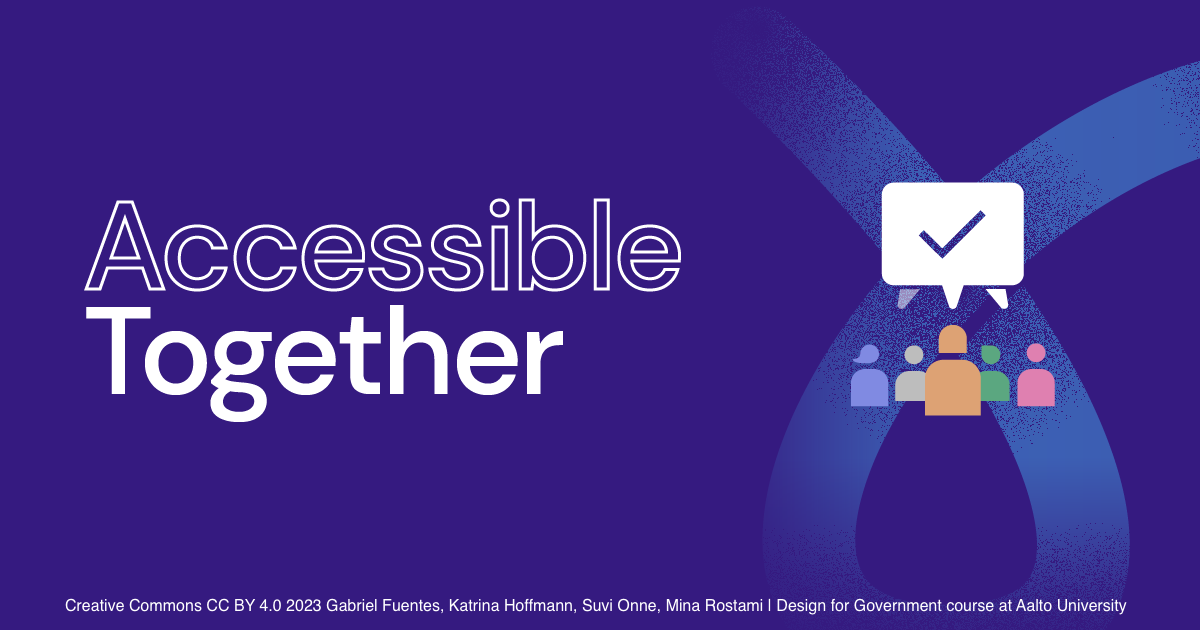This blog post reports on work-in-progress within the DfG course! The post is written group 2A. Together, we work in collaboration with the Ministry of Transport & Communications’ brief on ‘how to make Finland’s public transport system more accessible’. The group 2A includes Gabriel Fuentes from the Collaborative & Industrial Design program, Katrina Hoffmann from the Collaborative & Industrial Design program, Suvi Onne from the Creative Sustainability – Chemical engineering program, and Mina Rostami from the Creative Sustainability – Design program.
Written by: Gabriel Fuentes
This blog post marks the culmination of an intense three-month journey of profound learning. It represents the synthesis of our process into a comprehensive design proposal, encapsulating the valuable insights acquired throughout this period. “Accessible Together: A Framework of Collaboration for an Accessible Travel Chain” is an intervention aimed at facilitating more accessible travel chains across Finland. By fostering collaborative dynamics among the diverse stakeholders involved in its implementation, our proposal seeks to create a more inclusive and seamless travel experience throughout the country.
We strongly think that relying solely on isolated solutions is insufficient to tackle the broader challenges associated with collaboration. As our partners have highlighted, the idea of establishing committees within the public administration to address these issues is not new, but, unfortunately, these attempts usually just ended up with reports that didn’t really make a big difference. Consequently, the core of our design proposal revolves around building robust foundations that go beyond previous attempts. Our proposal strives to create a resilient framework—a multilayered structure designed to endure and capable of instilling a fresh mindset toward accessibility.

At its core, our proposal introduces a three-level framework aimed at fostering collaboration. This system of collaboration is purposefully designed to endure and adapt to the evolving context. Let’s take a look at each level:
1. Decision-making level: This level encompasses LVM’s branch dedicated to accessibility, which takes on the responsibility of establishing and maintaining a coordination committee. They also serve as the final decision-makers in determining the framework’s goals.
2. Coordination level: Represented by the previously mentioned committee, this level comprises LVM, various service providers, and accessibility organizations. Their main task is to collaborate on enhancing accessible transport chains and cultivating a culture of cooperation within this domain. The committee should possess decision-making authority and expertise, enabling them to mandate and prioritize accessibility issues. On top of what the core committee already knows, they have the flexibility to involve additional expertise when required, such as organizations representing users, smaller local operators, or municipalities.
3. Action level: Here is where we propose a pilot project, managed by the committee. It serves as a testing ground for services or products on a smaller scale, allowing for evaluation and data gathering to advance the project. For example, we have chosen stations along a travel chain, encompassing the entire door-to-door experience. Specifically, we are focusing on the most accessible transfer stations as part of a travel chain in three cities of varying sizes: Helsinki, Tampere, and Jyväskylä. We chose to work with stations as they were identified during interviews as areas lacking responsibility but involving multiple actors. Moreover, stations serve as connection points between operators and users. While the committee collaborates on this pilot, their underlying objective is to prototype a mode of collaboration with one another, making impactful changes to the accessible travel chain for end-users.
With our proposal, we wanted to establish a structure that facilitates communication between decision-makers and all the involved actors. It provides a clear and dynamic chain of coordination with the capacity to prototype solutions and establish well-defined responsibilities. Thus, this framework ensures a consistently high standard of accessibility throughout Finland. It is important to emphasize that the design intervention’s focus is not solely on the pilot project or the committee itself; instead, it centers on establishing a collaborative structure that encompasses everyone involved.
Sometimes solutions are more than simple than we think
As an outsider observing Finland, I am truly impressed by the tremendous effort invested by authorities and operators in delivering an exceptional transportation service. However, as emphasized by our partners, “If one part of the journey is inaccessible, the entire journey is inaccessible” This statement highlights the significant responsibility involved in achieving such an ambitious objective. As a result, personally, the main takeaway gained from this experience is the recognition that resolving such complex issues goes beyond relying solely on tools like technology, even in highly developed countries like Finland. Establishing a fully accessible travel chain, from start to finish, demands a deep willingness and commitment from all stakeholders. Ultimately, it hinges on genuine human cooperation, which, let’s face it, isn’t rocket science, right?
The DfG course runs for 14 weeks each spring – the 2023 course has now started and runs from 27 th February to 31 May. It’s an advanced studio course in which students work in multidisciplinary teams to address project briefs commissioned by governmental ministries in Finland. The course proceeds through the spring as a series of teaching modules in which various research and design methods are applied to address the project briefs. Blog posts are written by student groups, in which they share news, experiences, and insights from within the course activities and their project development. More information here about the DfG 2023 project briefs.

